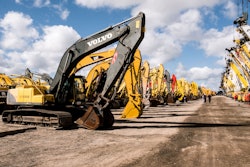
“It’s still a strong market, even though it’s not as good as last year,” says Michael Cole with Cole Equipment, a used equipment dealer in Ada, Oklahoma.
“The low-hour machines will still bring a premium, but there’s a lot of three- to five-year-old tractors out there in rental fleets, especially dealer rental fleets, that weren’t supposed to be around that long,” says Dennis Howard, vice president fleet and remarketing with Deere dealer RDO Equipment. “We’ll see that category start showing up on the market in the next three to six months and getting softer prices.”

Thanks to a booming economy, the current demand for used equipment is high and the supply of good machines somewhat limited, Alters says. “The energy sector – oil and gas – is still very strong, and we’re seeing some strengths in segments of the housing market as well,” he says. Availability would be even more constrained and prices for used equipment higher, except that the leasing companies and equipment rental fleets have put a lot of good low-hour used equipment into the market over the last two years, he says.
Upstream
The used equipment market is a downstream market, and three upstream forces are currently affecting it. They are the continuing difficulty in getting some types of new equipment, the number of machines coming off lease and the impact of the rental market.

“Longer lead times for new equipment certainly created increased demand for used equipment,” says Kenneth Tysinger with May Equipment, a Hyundai and Bell Equipment dealer with 13 locations in North Carolina and South Carolina. “With the rising cost of new equipment and the feeling we could be getting closer to the end of the economic cycle, some are hesitant to bite off a big acquisition right now and are looking to the used market and rentals to fill their short-term needs.”
Used equipment prices may be softening, but it’s hard to pinpoint why, says Mike Lester, vice president of Groff Tractor, a Case dealer headquartered in Mechanicsburg, Pennsylvania. “The market’s good, the economy’s good. There’s a shortage of new equipment right now, but why are prices softer?”

“Last year we had new equipment leases going out the door left and right,” Tysinger says, “but the banks and lenders have backed off the 12- and 24-month programs.” Longer lease cycles affect the availability of equipment in the used marketplace.
“We’re seeing more of an impact from leasing than from rental,” Howard says. After the lease is over, large fleets such as pipeline customers will return machines included in large lease agreements.
Finance companies, however, have not seen an increase in leased equipment returning to the market – at least, not yet. “We haven’t seen the two-year leases come back yet,” says Steven Nenn with Wells Fargo Finance. “I don’t think we’re there yet.”
What’s hot, what’s not
“Anything in the system with low hours in relation to years in service has sold very well,” says Doug Olive, Ritchie Bros. Auctioneers vice president of pricing and valuations. “On top of that, some of the pre-emissions-regulation equipment with lower hours has really held its price.”
“Excavators, wheel loaders, really anything with more than 6,000 hours, we’ve seen some softening in pricing on those assets,” Olive says. “As newer equipment eases up a bit, there’s more offerings in the marketplace, and contractors don’t have to chase the high-hour stuff as hard.”
For those looking to sell, Howard says, the value of low-hour used excavators will continue to hold steady, especially because of continuing new machine availability issues. “The used equipment market ebbs and flows, though,” Howard says. “One month we’ll see a high demand for articulated dump trucks, and next month, we’ll see a high demand for dozers.”
“Excavators are holding their own,” Lester says. “Backhoes are dropping in price, but I think that’s more because the industry is getting away from using backhoes in favor of mini excavators and compact track loaders.”
“There is a shortage of articulated trucks,” Tysinger says. “We’ve got 75 of them in our fleet, and every one is out on rent.” Tysinger also sees customers putting 24 to 30 months longer on dozers than normal, in part to avoid higher new machine costs. “Once they do come on the market, they’ve got more hours on them, and it’s softened up their value.”
“Large dozers, mid-sized excavators and articulated-truck prices have held up over the past year simply due to supply and demand factors,” Tysinger adds. “Mid-size to smaller dozers, larger excavators over 45 tons and single-drum-compactor values are down.”
Auction perspective
Ritchie Bros. is six months removed from its most successful auction ever, selling a record-breaking $297 million worth of used equipment during its Orlando, Florida, sale. The auction fueled a 17 percent increase in revenue for the company’s first quarter, to $303.4 million. And through the end of the year, there’s not going to be much of a tail-off, says Olive.

“Auction prices are for the most part on par with what we’ve seen in the past six to 12 months, adjusting for age and condition,” says Raffi Aharonian, managing director of Rouse Appraisals, a division of Rouse Services.
“There’s been moderation in some heavier earthmoving equipment valuations, ranging from 2 to 5 percent, depending on the product, but we haven’t been able to tie that to anything in particular,” Aharonian continues. “Overall auction volumes have increased on a year-over-year basis, so it may be just a matter of market absorption.”
Neil McIlwaine, business development manager at auction company Yoder & Frey, says a number of factors are contributing to used equipment price sensitivity. “We’re finding there is generally a surplus of larger equipment from two to five years old, often with high hours, such as 20- and 30-ton excavators,” he says.
The surpluses, and the price softening, stem from a number of recently completed large-scale infrastructure projects, he says.
The rebuilding of new-equipment inventory has also made used equipment buyers more selective. “It really is a buyer’s market out there,” McIlwaine says. “They’re spending more time securing an asset that is better suited for their needs for upcoming projects, something with fewer hours than they may have bought before, or less wear and tear, or an improved condition to what they’re used to in the past.”
There is still some high-demand equipment, says McIlwaine, but it is mostly niche machines and big machines. “Material processing equipment is in high demand. The quarries and the mining companies are asking us to alert them whenever specific used crushers or screens are made available through the auction,” he says.
But as buyers have become more sophisticated, sales prices have fewer wide fluctuations, says Howard Hawk, president of online auction site Bidadoo. “The retail price and the wholesale price used to be the two bookends,” he says. “You’ve seen an enormous collapse of that price stratification over time. So there’s really not that much price stratification between retail, wholesale, export and auction any longer.”
The rental factor
A key driver of used equipment supply is what’s coming out of rental fleets. The Rental Penetration Index, used by the American Rental Association to show the percentage of construction equipment in the United States owned by rental companies, is currently at 53.5 percent. The index has been above 52 percent since 2016.
Some of Bidadoo’s rental company clients expect to double or triple their budgets for fleet disposal in the next few years if economic forces hold steady, says Hawk. “Rental rates, demand and utilization rates are still pretty strong, but you can definitely see the growth flattening out,” he says. “Utilization rates are beginning to soften up a bit from the red-hot pace of the last couple of years, meaning the fleet companies will look toward increased used equipment sales.”
Rental firms hold a unique position in the used equipment market. Since a rental firm’s value proposition includes providing new or low-hour equipment, it typically only sells used equipment. With auction companies primarily providing selling services, most other players in the used equipment market – OEM and independent dealers, brokers, wholesalers, even end users – both buy and sell.
Because of the sheer number of machines they buy, rental fleets in turn produce major used equipment inventories. A critical component of a rental firm’s revenue structure is how much return it gets on disposing used assets, whether directly selling them to end users or using third-party sellers such as auction companies. Other avenues include trade-in packages with manufactures and using wholesalers.
Last year, for example, United Rentals said it sold more than 16,000 products. The company supports these sales with a United Guard extended warranty and in-house financing and offers a servicing program that provides inspections, PM programs and repairs by United Rentals technicians.
“To get an indication of what will eventually come downstream to the used equipment market, look at rental utilization rates,” says Aharonian. This is an indicator of equipment demand, equipment that typically makes its way into the used market.
Going forward
If you just look on a year-over-year basis, today’s used equipment environment can seem flat to moderately down, but those numbers should be put in context. “We’ve been riding some near all-time highs in terms of used equipment recoveries,” Aharonian says. “This year is up against a tough comp.”











